Social-Ecological Spatial Analysis of Agroforestry in the European Union with a Focus on Mediterranean Countries
Abstract
:1. Introduction
2. Materials and Methods
2.1. Study Area
2.2. LUCAS Harmonized Database
2.3. Agroforestry Systems
- AgroPastoral systems are identified as systems combining crops with signs of grazing. These systems include the subclasses B11–B54 of cropland (i.e., all the subclasses that any crop is planted and cultivated, except trees) with signs of grazing.
- AgroSilvo systems result from the combination of crops with cultivated trees. For this purpose, we combine the subclasses B71–B84 of cropland (i.e., all subclasses with cultivated trees), C10–C33 of woodland (i.e., all subclasses of woodland with a canopy covering ≥ 10% of the surface), and D10 of shrubland (i.e., areas dominated by ≥10% of their surface by shrubs, low woody species, and tree canopy < 10%) with the subclasses B11–B54 of cropland.
- AgroSilvoPastoral systems are defined as systems combining crops, cultivated trees, and signs of grazing. In essence, these systems emerged from the combination of all the areas included in the AgroSilvo system with signs of grazing, i.e., a combination of grazed woodland and cropland.
- SilvoPastoral systems include all the systems of the AgroSilvoPastoral system, but without the “Agro” component, i.e., systems where only tree cultivation and signs of grazing occurred at the same time and place.
2.4. Factors and Variables Selected and Ranked
2.4.1. European Biogeographical and Ecological Regions
2.4.2. Biophysical Factor
2.4.3. Bioclimatic Factor
- Annual mean temperature. The annual mean temperature approximates the total energy input for an ecosystem. The average temperature for each month, and then the average of these results over 12 months, were used.
- Temperature seasonality CV (standard deviation × 100). Temperature seasonality expresses the amount of temperature variation over a particular period based on the ratio of the standard deviation of the monthly mean temperatures to the mean monthly temperature (also known as the coefficient of variation, i.e., CV). The larger this percentage is, the greater the variability in temperature.
- Annual precipitation. This is the sum of all total monthly precipitation values. Annual total precipitation approximates the total water input and is, therefore, useful when determining the importance of water availability.
- Precipitation seasonality (Coefficient of Variation). It is the ratio of the standard deviation of the monthly total precipitation to the mean monthly total precipitation. It provides a percentage of precipitation variability, where a larger percentage represents greater variability in precipitation.
2.4.4. Topographic Factor
- Elevation was classified into five classes: <500 m, 500–1000 m, 1000–1500 m, 1500–2000 m, and >2000 m.
- Slope was divided into five levels: 0–2.5°, 2.5–5°, 5–7.5°, 7.5–10° and >10°.
- Aspect was classified into eight exposures (N, NE, E, SE, S, SW, W, NW).
2.4.5. Soil Factor
- Total organic carbon content. Soil organic carbon pools have received increasing attention from policymakers at national and sub-national levels because of their relevance to agriculture and food security, climate change, air and water pollution, and biodiversity [36]. Organic carbon serves as a soil conditioner, nutrient source, substrate for microbial activity, preserver of the environment, and the major determinant for sustaining or increasing agricultural productivity [37]. We classified and analyzed both topsoil and subsoil organic carbon separately. Six classes were considered: 0–1%, 1–2%, 2–6%, 6–12.5%, 12.5–25%, and >25%.
- Available water content. The soil’s available water content is crucial in agricultural systems, as soil is the main source of water for plant uptake. Soil water governs the soil’s physical condition and can affect the soil’s chemical and biological conditions, such as the plant uptake of nutrients and the activity of soil organisms [38]. The available water content used here is a volumetric parameter describing the water content between the field capacity and the permanent wilting point [39]. It is a function of field capacity, permanent wilting point, presence of coarse fragments, and depth [35]. Both topsoil and subsoil available water content were spatially analyzed after being categorized into five classes: <50 mm, 50–100 mm, 100–150 mm, 150–200 mm, and 200–250 mm.
- Texture. Texture is one of the most important properties of soil, and it greatly affects crop production, land use, and applied management. Soil texture is directly related to nutrient retention and drainage capabilities, e.g., coarser soils exhibit lower retention of nutrients and water [40]. Classification of soil texture was implemented according to Table 2 [35]. Both topsoil and subsoil textures were spatially analyzed.
2.4.6. Socioeconomic Factor
2.5. Spatial Statistical Analysis and Spatial Relationships Modeling
3. Results
3.1. Spatial Statistical Analysis
3.1.1. AgroPastoral System
3.1.2. AgroSilvo System
3.1.3. AgroSilvoPastoral System
3.1.4. SilvoPastoral System
3.2. Land Suitability for SilvoPastoral Agroforestry
3.2.1. Aegean & West Turkey Sclerophyllous and Mixed Forest Modeling
3.2.2. Adriatic Sclerophyllous and Mixed Forests Modeling
3.2.3. Iberian Sclerophyllous and Semi-Deciduous Forests Modeling
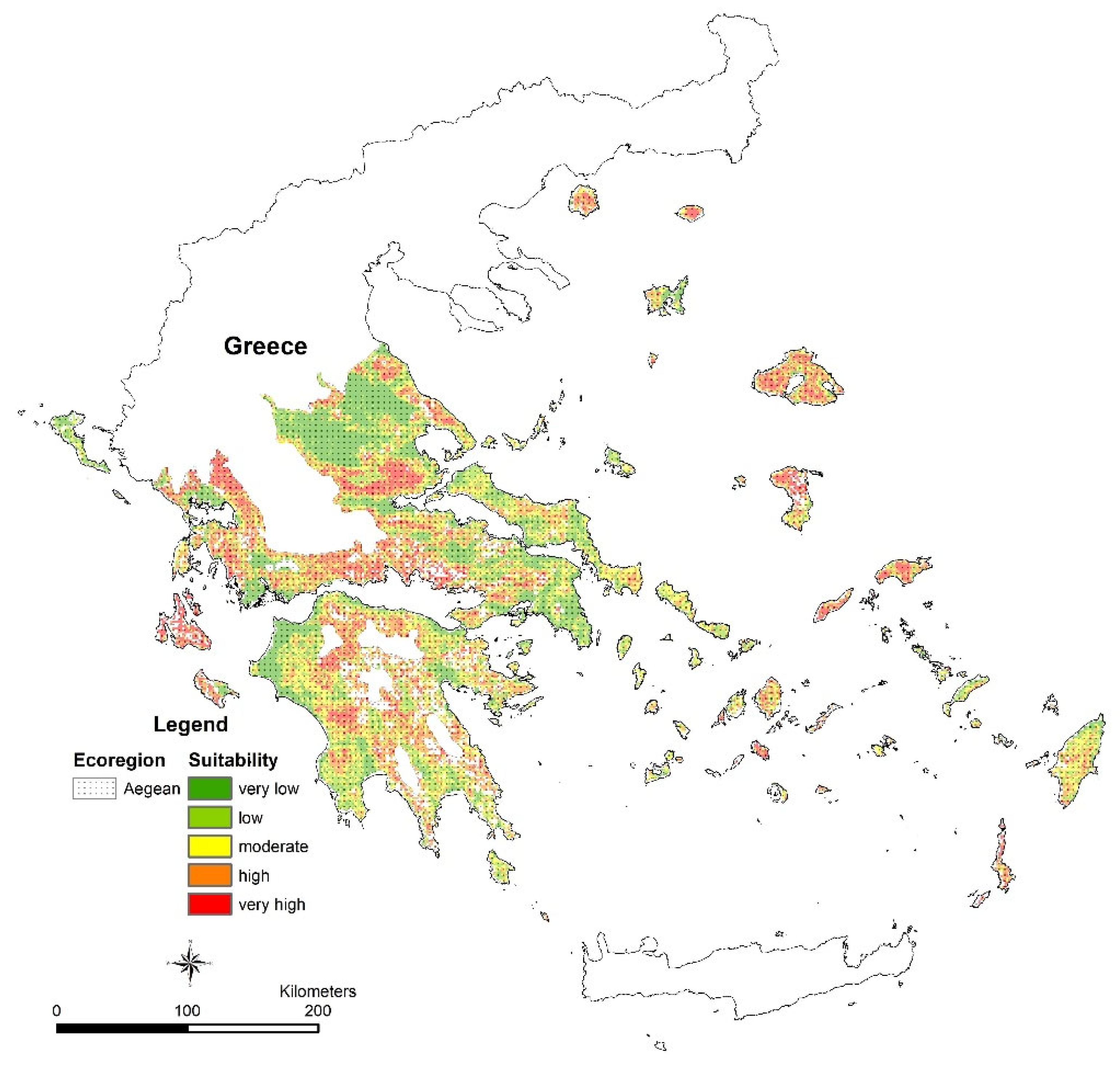

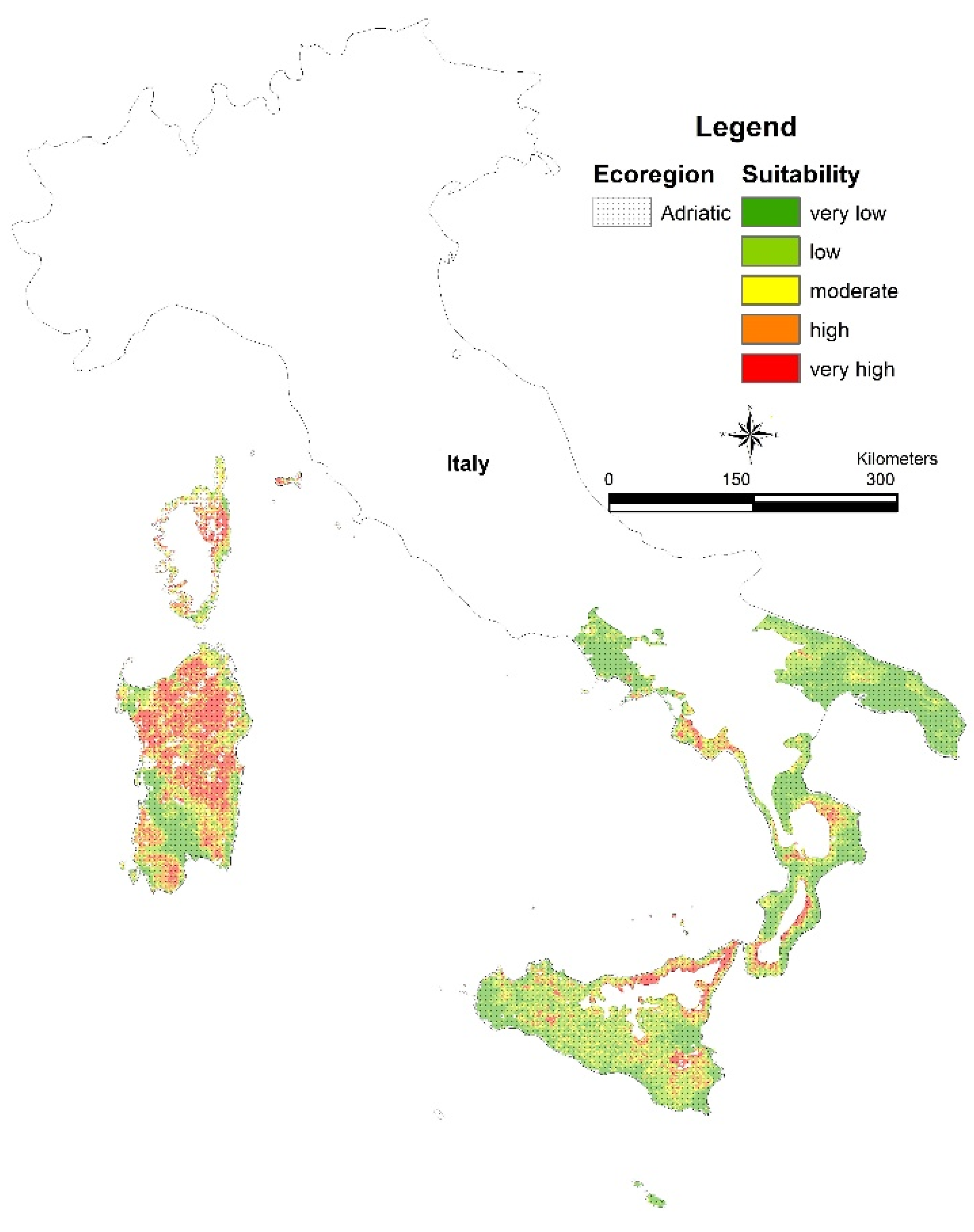
4. Discussion
4.1. Definition and Identification of Agroforestry Systems
4.2. Social-Ecological Factors of Agroforestry Suitability
5. Conclusions
Supplementary Materials
Author Contributions
Funding
Data Availability Statement
Conflicts of Interest
References
- Mosquera-Losada, M.R.; McAdam, J.H.; Romero-Franco, R.; Santiago-Freijanes, J.J.; Rigueiro-Rodróguez, A. Definitions and Components of Agroforestry Practices in Europe. In Agroforestry in Europe; Rigueiro-Rodróguez, A., McAdam, J., Mosquera-Losada, M.R., Eds.; Advances in Agroforestry; Springer: Dordrecht, The Netherlands, 2008; Volume 6, pp. 3–19. [Google Scholar]
- Rigueiro-Rodríguez, A.; Fernández-Núñez, E.; González-Hernández, P.; McAdam, J.H.; Mosquera-Losada, M.R. Agroforestry Systems in Europe: Productive, Ecological and Social Perspectives. In Agroforestry in Europe; Rigueiro-Rodróguez, A., McAdam, J., Mosquera-Losada, M.R., Eds.; Advances in Agroforestry; Springer: Dordrecht, The Netherlands, 2008; Volume 6, pp. 43–65. [Google Scholar]
- Becker, S.; Grajewski, R.; Rehburg, P. Where Does the CAP Money Go?: Design and Priorities of the Draft CAP Strategic Plans 2023–2027; Johann Heinrich von Thünen-Institut: Berlin, Germany, 2022. [Google Scholar]
- European Commission; Directorate General for Agriculture and Rural Development; Alliance Environnement. Evaluation Study of the Forestry Measures under Rural Development: Final Report; Publications Office: Luxembourg, 2017. [Google Scholar]
- Augère-Granier, M.-L. Agroforestry in the European Union; PE 651.982; European Parliamentary Research Service, European Union: Brussels, Belgium, 2020; pp. 1–11. [Google Scholar]
- Den Herder, M.; Moreno, G.; Mosquera-Losada, R.M.; Palma, J.H.N.; Sidiropoulou, A.; Santiago Freijanes, J.J.; Crous-Duran, J.; Paulo, J.A.; Tomé, M.; Pantera, A.; et al. Current Extent and Stratification of Agroforestry in the European Union. Agric. Ecosyst. Environ. 2017, 241, 121–132. [Google Scholar] [CrossRef]
- Bārdulis, A.; Ivanovs, J.; Bārdule, A.; Lazdiņa, D.; Purviņa, D.; Butlers, A.; Lazdiņš, A. Assessment of Agricultural Areas Suitable for Agroforestry in Latvia. Land 2022, 11, 1873. [Google Scholar] [CrossRef]
- Levers, C.; Müller, D.; Erb, K.; Haberl, H.; Jepsen, M.R.; Metzger, M.J.; Meyfroidt, P.; Plieninger, T.; Plutzar, C.; Stürck, J.; et al. Archetypical Patterns and Trajectories of Land Systems in Europe. Reg. Environ. Chang. 2015, 18, 715–732. [Google Scholar] [CrossRef]
- Iglesias, A.; Garrote, L.; Quiroga, S.; Moneo, M. A Regional Comparison of the Effects of Climate Change on Agricultural Crops in Europe. Clim. Chang. 2012, 112, 29–46. [Google Scholar] [CrossRef]
- Pazúr, R.; Nováček, J.; Bürgi, M.; Kopecká, M.; Lieskovský, J.; Pazúrová, Z.; Feranec, J. Changes in Grassland Cover in Europe from 1990 to 2018: Trajectories and Spatial Patterns. Reg. Environ. Chang. 2024, 24, 51. [Google Scholar] [CrossRef]
- Benayas, J.R.; Martins, A.; Nicolau, J.M.; Schulz, J.J. Abandonment of Agricultural Land: An Overview of Drivers and Consequences. CAB Rev. Perspect. Agric. Vet. Sci. Nutr. Nat. Resour. 2007, 2, 57. [Google Scholar] [CrossRef]
- MacDonald, D.; Crabtree, J.R.; Wiesinger, G.; Dax, T.; Stamou, N.; Fleury, P.; Gutierrez Lazpita, J.; Gibon, A. Agricultural Abandonment in Mountain Areas of Europe: Environmental Consequences and Policy Response. J. Environ. Manag. 2000, 59, 47–69. [Google Scholar] [CrossRef]
- Chouvardas, D.; Karatassiou, M.; Stergiou, A.; Chrysanthopoulou, G. Identifying the Spatiotemporal Transitions and Future Development of a Grazed Mediterranean Landscape of South Greece. Land 2022, 11, 2141. [Google Scholar] [CrossRef]
- Pandey, R.; Aretano, R.; Gupta, A.K.; Meena, D.; Kumar, B.; Alatalo, J.M. Agroecology as a Climate Change Adaptation Strategy for Smallholders of Tehri-Garhwal in the Indian Himalayan Region. Small-Scale For. 2017, 16, 53–63. [Google Scholar] [CrossRef]
- Mbow, C.; Van Noordwijk, M.; Prabhu, R.; Simons, T. Knowledge Gaps and Research Needs Concerning Agroforestry’s Contribution to Sustainable Development Goals in Africa. Curr. Opin. Environ. Sustain. 2014, 6, 162–170. [Google Scholar] [CrossRef]
- Nath, A.J.; Kumar, R.; Devi, N.B.; Rocky, P.; Giri, K.; Sahoo, U.K.; Bajpai, R.K.; Sahu, N.; Pandey, R. Agroforestry Land Suitability Analysis in the Eastern Indian Himalayan Region. Environ. Chall. 2021, 4, 100199. [Google Scholar] [CrossRef]
- Coe, R.; Sinclair, F.; Barrios, E. Scaling up Agroforestry Requires Research ‘in’ Rather than ‘for’ Development. Curr. Opin. Environ. Sustain. 2014, 6, 73–77. [Google Scholar] [CrossRef]
- Collins, M.G.; Steiner, F.R.; Rushman, M.J. Land-Use Suitability Analysis in the United States: Historical Development and Promising Technological Achievements. Environ. Manag. 2001, 28, 611–621. [Google Scholar] [CrossRef] [PubMed]
- Lopresti, M.F.; Di Bella, C.M.; Degioanni, A.J. Relationship between MODIS-NDVI Data and Wheat Yield: A Case Study in Northern Buenos Aires Province, Argentina. Inf. Process. Agric. 2015, 2, 73–84. [Google Scholar] [CrossRef]
- Bilas, G.; Karapetsas, N.; Gobin, A.; Mesdanitis, K.; Toth, G.; Hermann, T.; Wang, Y.; Luo, L.; Koutsos, T.M.; Moshou, D.; et al. Land Suitability Analysis as a Tool for Evaluating Soil-Improving Cropping Systems. Land 2022, 11, 2200. [Google Scholar] [CrossRef]
- Zolekar, R.B.; Bhagat, V.S. Multi-Criteria Land Suitability Analysis for Agriculture in Hilly Zone: Remote Sensing and GIS Approach. Comput. Electron. Agric. 2015, 118, 300–321. [Google Scholar] [CrossRef]
- Ahmad, F.; Goparaju, L. Geospatial Approach for Agroforestry Suitability Mapping: To Enhance Livelihood and Reduce Poverty, FAO Based Documented Procedure (Case Study of Dumka District, Jharkhand, India). Biosci. Biotechnol. Res. Asia 2017, 14, 651–665. [Google Scholar] [CrossRef]
- Phillips, S.J.; Anderson, R.P.; Schapire, R.E. Maximum Entropy Modeling of Species Geographic Distributions. Ecol. Model. 2006, 190, 231–259. [Google Scholar] [CrossRef]
- Stockwell, D. The GARP Modelling System: Problems and Solutions to Automated Spatial Prediction. Int. J. Geogr. Inf. Sci. 1999, 13, 143–158. [Google Scholar] [CrossRef]
- Heumann, B.W.; Walsh, S.J.; McDaniel, P.M. Assessing the Application of a Geographic Presence-Only Model for Land Suitability Mapping. Ecol. Inform. 2011, 6, 257–269. [Google Scholar] [CrossRef] [PubMed]
- Fitzgibbon, A.; Pisut, D.; Fleisher, D. Evaluation of Maximum Entropy (MaxEnt) Machine Learning Model to Assess Relationships between Climate and Corn Suitability. Land 2022, 11, 1382. [Google Scholar] [CrossRef]
- d’Andrimont, R.; Yordanov, M.; Martinez-Sanchez, L.; Eiselt, B.; Palmieri, A.; Dominici, P.; Gallego, J.; Reuter, H.I.; Joebges, C.; Lemoine, G.; et al. Harmonised LUCAS In-Situ Land Cover and Use Database for Field Surveys from 2006 to 2018 in the European Union. Sci. Data 2020, 7, 352. [Google Scholar] [CrossRef] [PubMed]
- Ballin, M.; Barcaroli, G.; Masselli, M.; Scarnó, M. Redesign Sample for Land Use/Cover Area Frame Survey (LUCAS) 2018; European Commission, Statistical Office of the European Union Publications Office: Luxembourg, 2018. [Google Scholar]
- Dmuchowski, W.; Baczewska-Dąbrowska, A.H.; Gworek, B. The Role of Temperate Agroforestry in Mitigating Climate Change: A Review. For. Policy Econ. 2024, 159, 103136. [Google Scholar] [CrossRef]
- Kay, S.; Rega, C.; Moreno, G.; Den Herder, M.; Palma, J.H.N.; Borek, R.; Crous-Duran, J.; Freese, D.; Giannitsopoulos, M.; Graves, A.; et al. Agroforestry Creates Carbon Sinks Whilst Enhancing the Environment in Agricultural Landscapes in Europe. Land Use Policy 2019, 83, 581–593. [Google Scholar] [CrossRef]
- European Environment Agency (EEA). Biogeographical and Marine Regions in the EU. Available online: https://www.eea.europa.eu/data-and-maps/figures/biogeographical-and-marine-regions-in (accessed on 21 May 2024).
- European Environment Agency (EEA). DMEER: Digital Map of European Ecological Regions. Available online: https://www.eea.europa.eu/data-and-maps/figures/dmeer-digital-map-of-european-ecological-regions (accessed on 21 May 2024).
- Fick, S.E.; Hijmans, R.J. WorldClim 2: New 1-km Spatial Resolution Climate Surfaces for Global Land Areas. Int. J. Climatol. 2017, 37, 4302–4315. [Google Scholar] [CrossRef]
- Panagos, P.; Van Liedekerke, M.; Jones, A.; Montanarella, L. European Soil Data Centre: Response to European Policy Support and Public Data Requirements. Land Use Policy 2012, 29, 329–338. [Google Scholar] [CrossRef]
- Hiederer, R. Mapping Soil Properties for Europe: Spatial Representation of Soil Database Attributes; Publications Office of the European Union: Luxembourg, 2013. [Google Scholar]
- De Brogniez, D.; Ballabio, C.; Van Wesemael, B.; Jones, R.J.A.; Stevens, A.; Montanarella, L. Topsoil Organic Carbon Map of Europe. In Soil Carbon; Hartemink, A.E., McSweeney, K., Eds.; Springer International Publishing: Cham, Switzerland, 2014; pp. 393–405. [Google Scholar]
- Nieder, R.; Benbi, D.K. Carbon and Nitrogen in the Terrestrial Environment; Springer: Dordrecht, The Netherlands, 2008. [Google Scholar]
- Asgarzadeh, H.; Mosaddeghi, M.R.; Mahboubi, A.A.; Nosrati, A.; Dexter, A.R. Soil Water Availability for Plants as Quantified by Conventional Available Water, Least Limiting Water Range and Integral Water Capacity. Plant Soil 2010, 335, 229–244. [Google Scholar] [CrossRef]
- Richards, L.; Wadleigh, C. Soil Water and Plant Growth. Soil Phys. Cond. Plant Growth 1952, 2, 74–253. [Google Scholar]
- Jaja, N. Understanding the Texture of Your Soil for Agricultural Productivity; Virginia Cooperative Extension: Blacksburg, VA, USA, 2016. [Google Scholar]
- Glover, E.K.; Ahmed, H.B.; Glover, M.K. Analysis of Socio-Economic Conditions Influencing Adoption of Agroforestry Practices. Int. J. Agric. For. 2013, 3, 178–184. [Google Scholar]
- Eurostat. Population Structure Indicators at National Level. Available online: https://ec.europa.eu/eurostat/databrowser/product/page/DEMO_PJANIND (accessed on 9 May 2024).
- Gallego, F.J. A Population Density Grid of the European Union. Popul. Environ. 2010, 31, 460–473. [Google Scholar] [CrossRef]
- Phillips, S.J.; Anderson, R.P.; Dudík, M.; Schapire, R.E.; Blair, M.E. Opening the Black Box: An Open-source Release of MaxEnt. Ecography 2017, 40, 887–893. [Google Scholar] [CrossRef]
- Feng, X.; Park, D.S.; Liang, Y.; Pandey, R.; Papeş, M. Collinearity in Ecological Niche Modeling: Confusions and Challenges. Ecol. Evol. 2019, 9, 10365–10376. [Google Scholar] [CrossRef] [PubMed]
- Morales, N.S.; Fernández, I.C.; Baca-González, V. MaxEnt’s Parameter Configuration and Small Samples: Are We Paying Attention to Recommendations? A Systematic Review. PeerJ 2017, 5, e3093. [Google Scholar] [CrossRef] [PubMed]
- Muscarella, R.; Galante, P.J.; Soley-Guardia, M.; Boria, R.A.; Kass, J.M.; Uriarte, M.; Anderson, R.P. ENMeval: An R Package for Conducting Spatially Independent Evaluations and Estimating Optimal Model Complexity for MaxEnt Ecological Niche Models. Methods Ecol. Evol. 2014, 5, 1198–1205. [Google Scholar] [CrossRef]
- Nair, P.K.R.; Kumar, B.M.; Nair, V.D. An Introduction to Agroforestry: Four Decades of Scientific Developments; Springer International Publishing: Cham, Switzerland, 2021. [Google Scholar]
- Etienne, M. Research on Temperate and Tropical Silvopastoral Systems: A Review. In Western European Silvopastoral Systems; Etienne, M., Ed.; Science Update; INRA: Versailles, France, 1996; pp. 5–19. [Google Scholar]
- Papanastasis, V.P. Silvopastoral Systems and Range Management in the Mediterranean Region. In Western European Silvopastoral Systems; Etienne, M., Ed.; Science Update; INRA: Versailles, France, 1996; pp. 143–156. [Google Scholar]
- San Miguel-Ayanz, A. Mediterranean European Silvopastoral Systems. In Silvopastoralism and Sustainable Land Management. Proceedings of an International Congress on Silvopastoralism and Sustainable Management Held in Lugo, Spain, April 2004; CABI Publishing: Wallingford, UK, 2005; pp. 36–40. [Google Scholar]
- Merow, C.; Smith, M.J.; Silander, J.A. A Practical Guide to MaxEnt for Modeling Species’ Distributions: What It Does, and Why Inputs and Settings Matter. Ecography 2013, 36, 1058–1069. [Google Scholar] [CrossRef]
- Burnham, K.P.; Anderson, D.R. Model Selection and Multimodel Inference: A Practical Information-Theoretic Approach; Springer: Berlin/Heidelberg, Germany, 2002. [Google Scholar]
- Liu, C.; White, M.; Newell, G. Measuring and Comparing the Accuracy of Species Distribution Models with Presence-Absence Data. Ecography 2011, 34, 232–243. [Google Scholar] [CrossRef]
- Araújo, M.B.; Pearson, R.G.; Thuiller, W.; Erhard, M. Validation of Species–Climate Impact Models under Climate Change. Glob. Chang. Biol. 2005, 11, 1504–1513. [Google Scholar] [CrossRef]
- Burgess, P.J.; Rosati, A. Advances in European Agroforestry: Results from the AGFORWARD Project. Agrofor. Syst. 2018, 92, 801–810. [Google Scholar] [CrossRef]
- Nair, P.K.R.; Kumar, B.M.; Nair, V.D. Classification of Agroforestry Systems. In An Introduction to Agroforestry; Springer International Publishing: Cham, Switzerland, 2021; pp. 29–44. [Google Scholar]
- Zomer, R.J.; Trabucco, A.; Coe, R.; Place, F. Trees on Farm: Analysis of Global Extent and Geographical Patterns of Agroforestry. ICRAF Work. Pap.-World Agrofor. Cent. 2009, 63, 30. [Google Scholar]
- Nerlich, K.; Graeff-Hönninger, S.; Claupein, W. Agroforestry in Europe: A Review of the Disappearance of Traditional Systems and Development of Modern Agroforestry Practices, with Emphasis on Experiences in Germany. Agrofor. Syst. 2013, 87, 475–492. [Google Scholar] [CrossRef]
- San, A.; Pérez-Carral, C. Deer and Traditional Agrosilvopastoral Systems of Mediterranean Spain. A New Problem of Sustainability for a New Concept of Land Use. Cah. Options Méditerranéennes 1999, 39, 261–264. [Google Scholar]
- Papanastasis, V. Grasslands and Woody Plants in Europe with Special Reference to Greece. In Proceedings of the International Occasional Symposium of the European Grassland Federation, Thessaloniki, Greece, 27–29 May 1999; pp. 15–24. [Google Scholar]
- Donham, J.; Venn, R.; Migliorini, P.; Schmutz, U. European State of Agroforestry: An Overview of the Current Policy Contexts. In Proceedings of the 6th European Agroforestry Conference, Nuoro, Italy, 16–20 May 2022; pp. 16–20. [Google Scholar]
- Szott, L.T.; Fernandes, E.C.M.; Sanchez, P.A. Soil-Plant Interactions in Agroforestry Systems. For. Ecol. Manag. 1991, 45, 127–152. [Google Scholar] [CrossRef]
- Zomeni, M.; Tzanopoulos, J.; Pantis, J.D. Historical Analysis of Landscape Change Using Remote Sensing Techniques: An Explanatory Tool for Agricultural Transformation in Greek Rural Areas. Landsc. Urban Plan. 2008, 86, 38–46. [Google Scholar] [CrossRef]
- Kiziridis, D.A.; Mastrogianni, A.; Pleniou, M.; Karadimou, E.; Tsiftsis, S.; Xystrakis, F.; Tsiripidis, I. Acceleration and Relocation of Abandonment in a Mediterranean Mountainous Landscape: Drivers, Consequences, and Management Implications. Land 2022, 11, 406. [Google Scholar] [CrossRef]
- Chouvardas, D.; Karatassiou, M.; Tsioras, P.; Tsividis, I.; Palaiochorinos, S. Spatiotemporal Changes (1945–2020) in a Grazed Landscape of Northern Greece, in Relation to Socioeconomic Changes. Land 2022, 11, 1987. [Google Scholar] [CrossRef]
- Hinojosa, L.; Napoléone, C.; Moulery, M.; Lambin, E.F. The “Mountain Effect” in the Abandonment of Grasslands: Insights from the French Southern Alps. Agric. Ecosyst. Environ. 2016, 221, 115–124. [Google Scholar] [CrossRef]
- Papanastasis, V.P.; Mantzanas, K.; Dini-Papanastasi, O.; Ispikoudis, I. Traditional Agroforestry Systems and Their Evolution in Greece. In Agroforestry in Europe; Rigueiro-Rodróguez, A., McAdam, J., Mosquera-Losada, M.R., Eds.; Advances in Agroforestry; Springer: Dordrecht, The Netherlands, 2009; Volume 6, pp. 89–109. ISBN 978-1-4020-8271-9. [Google Scholar]
- Papachristou, T.G.; Platis, P.D. The Impact of Cattle and Goats Grazing on Vegetation in Oak Stands of Varying Coppicing Age. Acta Oecologica 2011, 37, 16–22. [Google Scholar] [CrossRef]
- Papachristou, T.G.; Platis, P.D.; Nastis, A.S. Foraging Behaviour of Cattle and Goats in Oak Forest Stands of Varying Coppicing Age in Northern Greece. Small Rumin. Res. 2005, 59, 181–189. [Google Scholar] [CrossRef]
- Mosquera-Losada, M.R.; Moreno, G.; Pardini, A.; McAdam, J.H.; Papanastasis, V.; Burgess, P.J.; Lamersdorf, N.; Castro, M.; Liagre, F.; Rigueiro-Rodríguez, A. Past, Present and Future of Agroforestry Systems in Europe. In Agroforestry—The Future of Global Land Use; Nair, P.K.R., Garrity, D., Eds.; Advances in Agroforestry; Springer: Dordrecht, The Netherlands, 2012; Volume 9, pp. 285–312. ISBN 978-94-007-4675-6. [Google Scholar]
- Mastrogianni, A.; Kiziridis, D.A.; Karadimou, E.; Pleniou, M.; Xystrakis, F.; Tsiftsis, S.; Tsiripidis, I. Community-Level Differentiation of Grime’s CSR Strategies along a Post-Abandonment Secondary Successional Gradient. Flora 2023, 308, 152399. [Google Scholar] [CrossRef]
- Nasiakou, S.; Vrahnakis, M.; Chouvardas, D.; Mamanis, G.; Kleftoyanni, V. Land Use Changes for Investments in Silvoarable Agriculture Projected by the CLUE-S Spatio-Temporal Model. Land 2022, 11, 598. [Google Scholar] [CrossRef]
- Keenleyside, C.; Jones, G.; Tucker, G.; Beaufoy, G. High Nature Value Farming throughout EU-27 and Its Financial Support under the CAP Final Report; Publications Office: Luxembourg, 2014. [Google Scholar]
- Kiziridis, D.A.; Mastrogianni, A.; Pleniou, M.; Tsiftsis, S.; Xystrakis, F.; Tsiripidis, I. Simulating Future Land Use and Cover of a Mediterranean Mountainous Area: The Effect of Socioeconomic Demands and Climatic Changes. Land 2023, 12, 253. [Google Scholar] [CrossRef]
- Ameztegui, A.; Morán-Ordóñez, A.; Márquez, A.; Blázquez-Casado, Á.; Pla, M.; Villero, D.; García, M.B.; Errea, M.P.; Coll, L. Forest Expansion in Mountain Protected Areas: Trends and Consequences for the Landscape. Landsc. Urban Plan. 2021, 216, 104240. [Google Scholar] [CrossRef]
- Lasanta-Martínez, T.; Vicente-Serrano, S.M.; Cuadrat-Prats, J.M. Mountain Mediterranean Landscape Evolution Caused by the Abandonment of Traditional Primary Activities: A Study of the Spanish Central Pyrenees. Appl. Geogr. 2005, 25, 47–65. [Google Scholar] [CrossRef]
- Pelorosso, R.; Leone, A.; Boccia, L. Land Cover and Land Use Change in the Italian Central Apennines: A Comparison of Assessment Methods. Appl. Geogr. 2009, 29, 35–48. [Google Scholar] [CrossRef]
- García-Ruiz, J.M.; Lasanta, T.; Nadal-Romero, E.; Lana-Renault, N.; Álvarez-Farizo, B. Rewilding and Restoring Cultural Landscapes in Mediterranean Mountains: Opportunities and Challenges. Land Use Policy 2020, 99, 104850. [Google Scholar] [CrossRef]
- Nori, M.; Farinella, D. Migration, Agriculture and Rural Development: IMISCOE Short Reader; IMISCOE Research Series; Springer International Publishing: Cham, Switzerland, 2020. [Google Scholar]
- Delattre, L.; Debolini, M.; Paoli, J.C.; Napoleone, C.; Moulery, M.; Leonelli, L.; Santucci, P. Understanding the Relationships between Extensive Livestock Systems, Land-Cover Changes, and CAP Support in Less-Favored Mediterranean Areas. Land 2020, 9, 518. [Google Scholar] [CrossRef]
- Sirami, C.; Nespoulous, A.; Cheylan, J.-P.; Marty, P.; Hvenegaard, G.T.; Geniez, P.; Schatz, B.; Martin, J.-L. Long-Term Anthropogenic and Ecological Dynamics of a Mediterranean Landscape: Impacts on Multiple Taxa. Landsc. Urban Plan. 2010, 96, 214–223. [Google Scholar] [CrossRef]
- Mosquera-Losada, M. Agroforestry as a Tool to Mitigate and Adapt to Climate under LULUCF Accounting. In Proceedings of the 3rd European Agroforestry Conference, Montpellier, France, 23–25 May 2016; EURAF: Montpellier, France, 2016; pp. 200–202. [Google Scholar]
- Mosquera-Losada, M.R.; Santos, M.G.S.; Gonçalves, B.; Ferreiro-Domínguez, N.; Castro, M.; Rigueiro-Rodríguez, A.; González-Hernández, M.P.; Fernández-Lorenzo, J.L.; Romero-Franco, R.; Aldrey-Vázquez, J.A.; et al. Policy Challenges for Agroforestry Implementation in Europe. Front. For. Glob. Chang. 2023, 6, 1127601. [Google Scholar] [CrossRef]
- Current, D.; Lutz, E.; Scherr, S.J. The Costs and Benefits of Agroforestry to Farmers. World Bank Res. Obs. 1995, 10, 151–180. [Google Scholar] [CrossRef]
- Wilkens, P.; Munsell, J.F.; Fike, J.H.; Pent, G.J.; Frey, G.E.; Addlestone, B.J.; Downing, A.K. Thinning Forests or Planting Fields? Producer Preferences for Establishing Silvopasture. Agrofor. Syst. 2022, 96, 553–564. [Google Scholar] [CrossRef]
- Palma, J.H.N.; Paulo, J.A.; Faias, S.P.; Garcia-Gonzalo, J.; Borges, J.G.; Tomé, M. Adaptive Management and Debarking Schedule Optimization of Quercus suber L. Stands under Climate Change: Case Study in Chamusca, Portugal. Reg. Environ. Chang. 2015, 15, 1569–1580. [Google Scholar] [CrossRef]
- Lovrić, M.; Rois-Díaz, M.; Den Herder, M.; Pisanelli, A.; Lovrić, N.; Burgess, P.J. Driving Forces for Agroforestry Uptake in Mediterranean Europe: Application of the Analytic Network Process. Agrofor. Syst. 2018, 92, 863–876. [Google Scholar] [CrossRef]
- Rigueiro-Rodríguez, A.; McAdam, J.H.; Mosquera-Losada, M.R. Agroforestry in Europe: Current Status and Future Prospects; Advances in Agroforestry; Springer: Berlin/Heidelberg, Germany, 2009. [Google Scholar]
- Reisner, Y.; De Filippi, R.; Herzog, F.; Palma, J. Target Regions for Silvoarable Agroforestry in Europe. Ecol. Eng. 2007, 29, 401–418. [Google Scholar] [CrossRef]
- Uthes, S.; Matzdorf, B.; Müller, K.; Kaechele, H. Spatial Targeting of Agri-Environmental Measures: Cost-Effectiveness and Distributional Consequences. Environ. Manag. 2010, 46, 494–509. [Google Scholar] [CrossRef] [PubMed]
- Stetter, C.; Mennig, P.; Sauer, J. Using Machine Learning to Identify Heterogeneous Impacts of Agri-Environment Schemes in the EU: A Case Study. Eur. Rev. Agric. Econ. 2022, 49, 723–759. [Google Scholar] [CrossRef]
- Lecegui, A.; Olaizola, A.M.; Varela, E. Disentangling the Role of Management Practices on Ecosystem Services Delivery in Mediterranean Silvopastoral Systems: Synergies and Trade-Offs through Expert-Based Assessment. For. Ecol. Manag. 2022, 517, 120273. [Google Scholar] [CrossRef]
- Karmiris, I.; Papachristou, T.G.; Fotakis, D. Abandonment of Silvopastoral Practices Affects the Use of Habitats by the European Hare (Lepus europaeus). Agriculture 2022, 12, 678. [Google Scholar] [CrossRef]
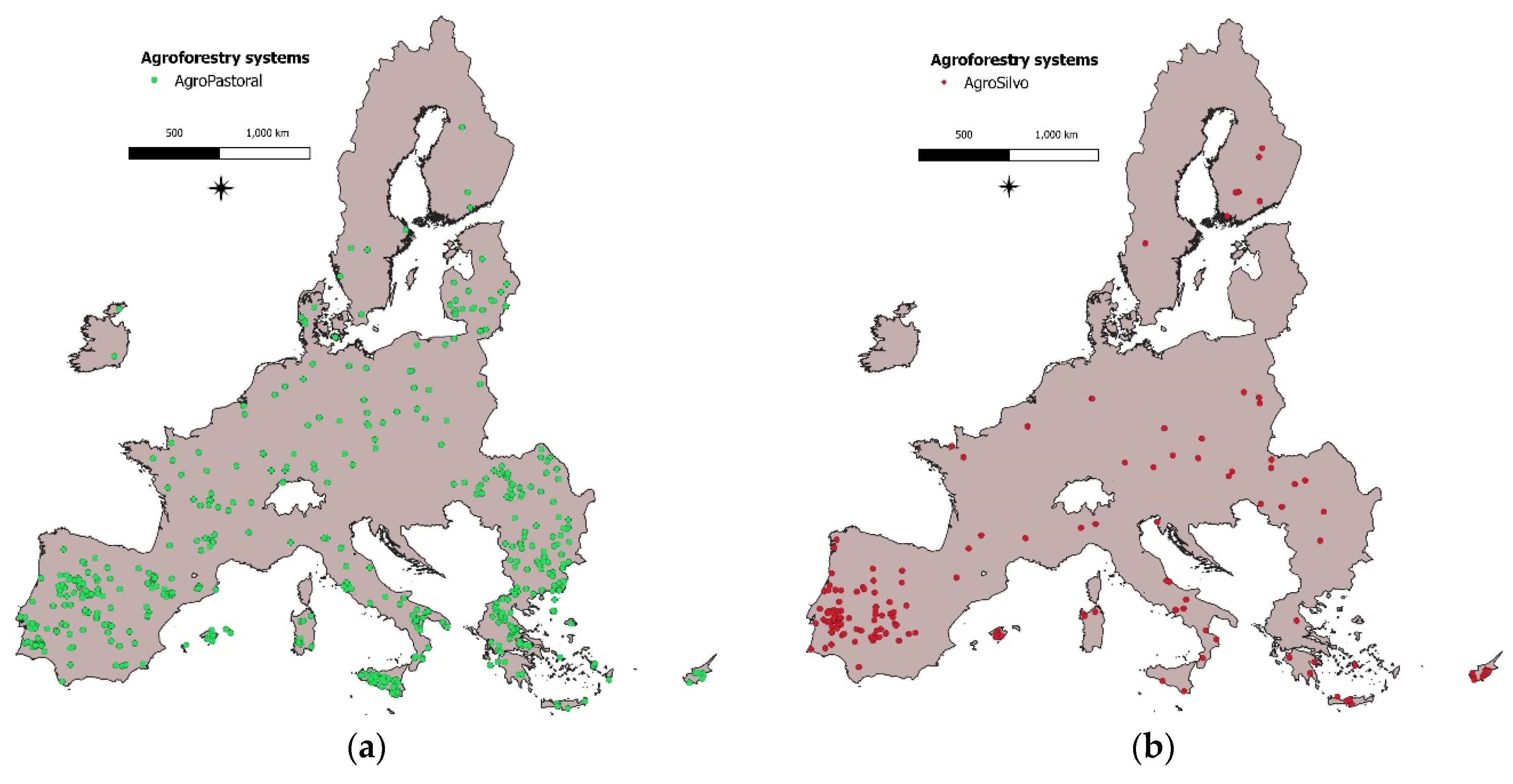
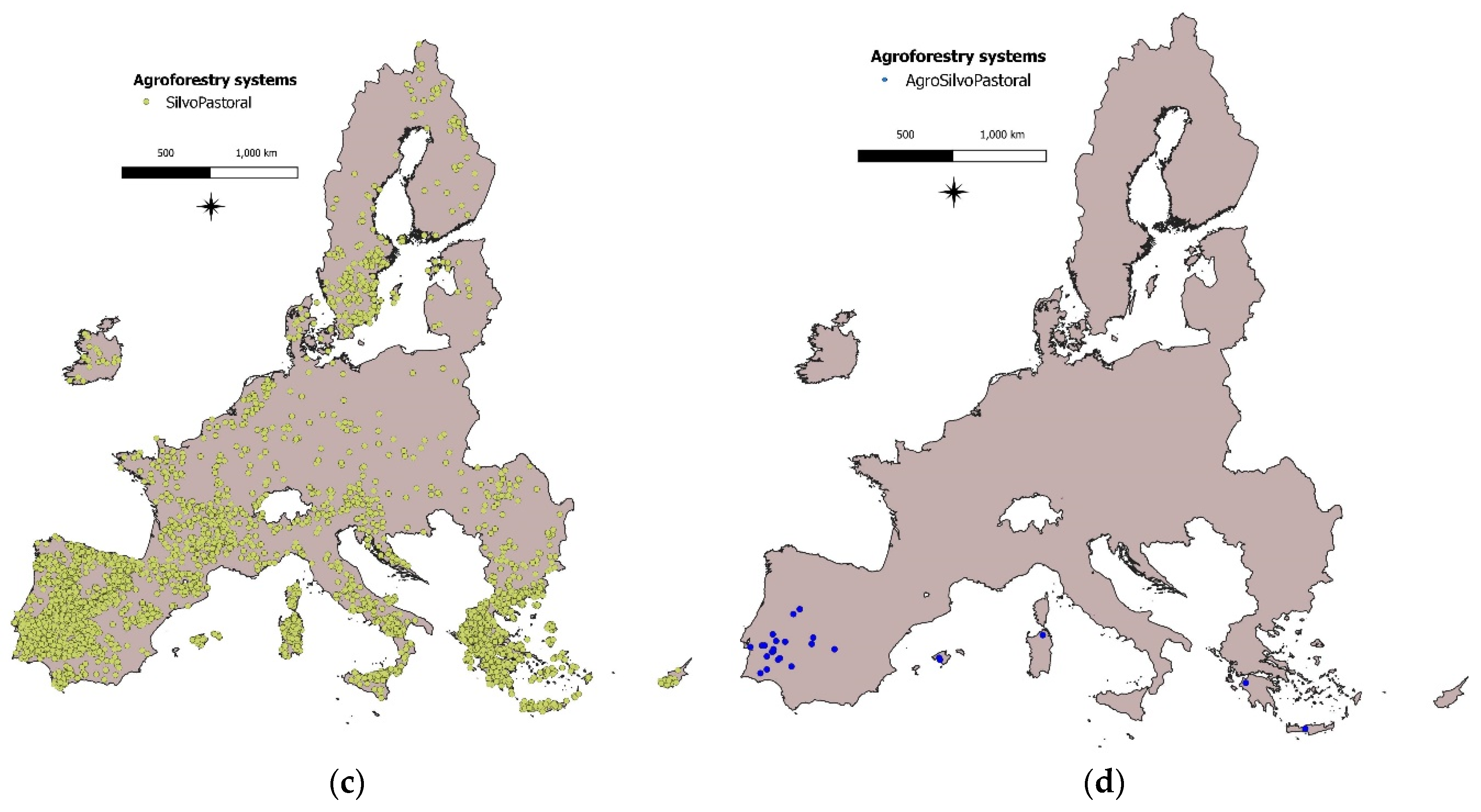
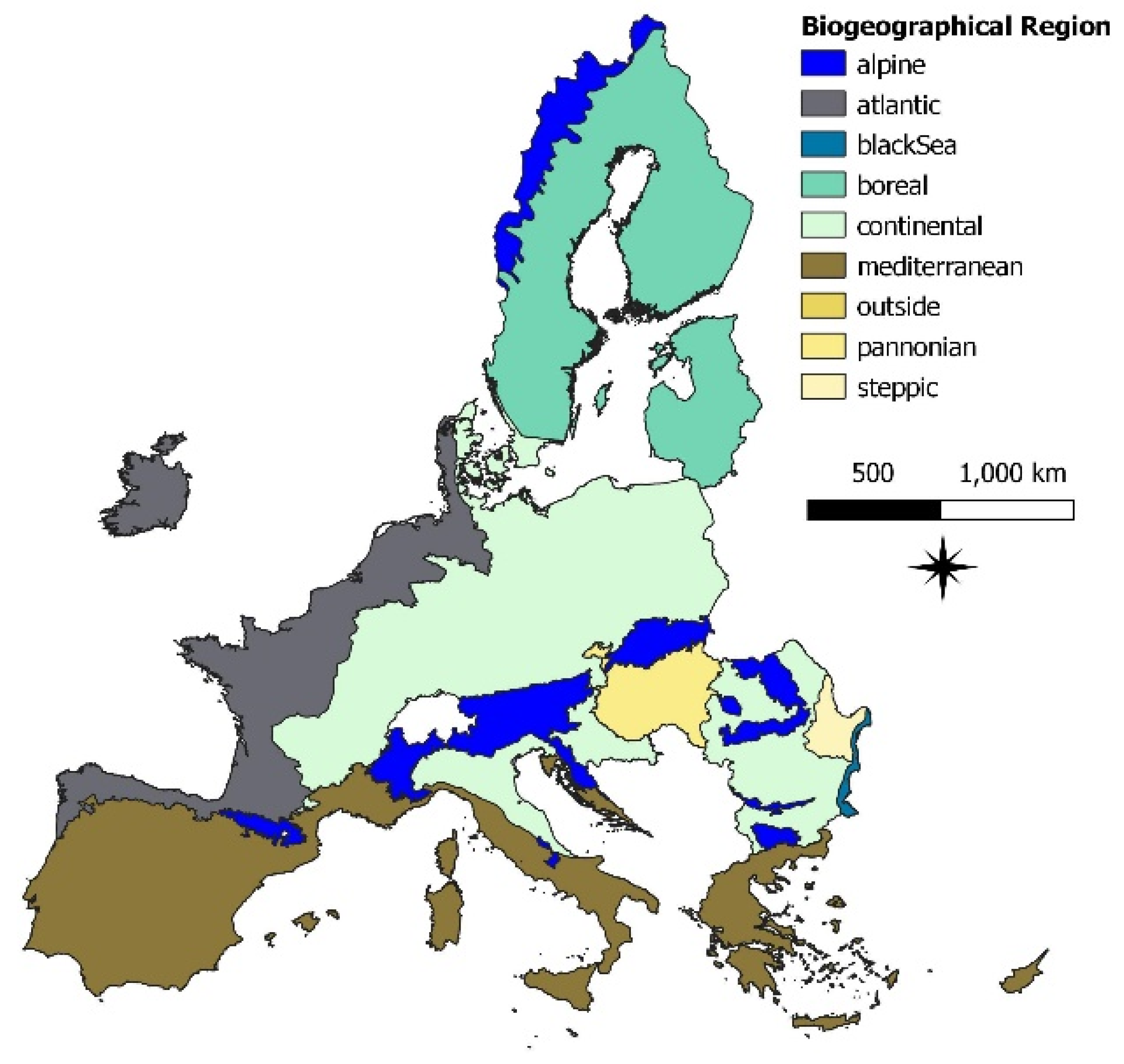
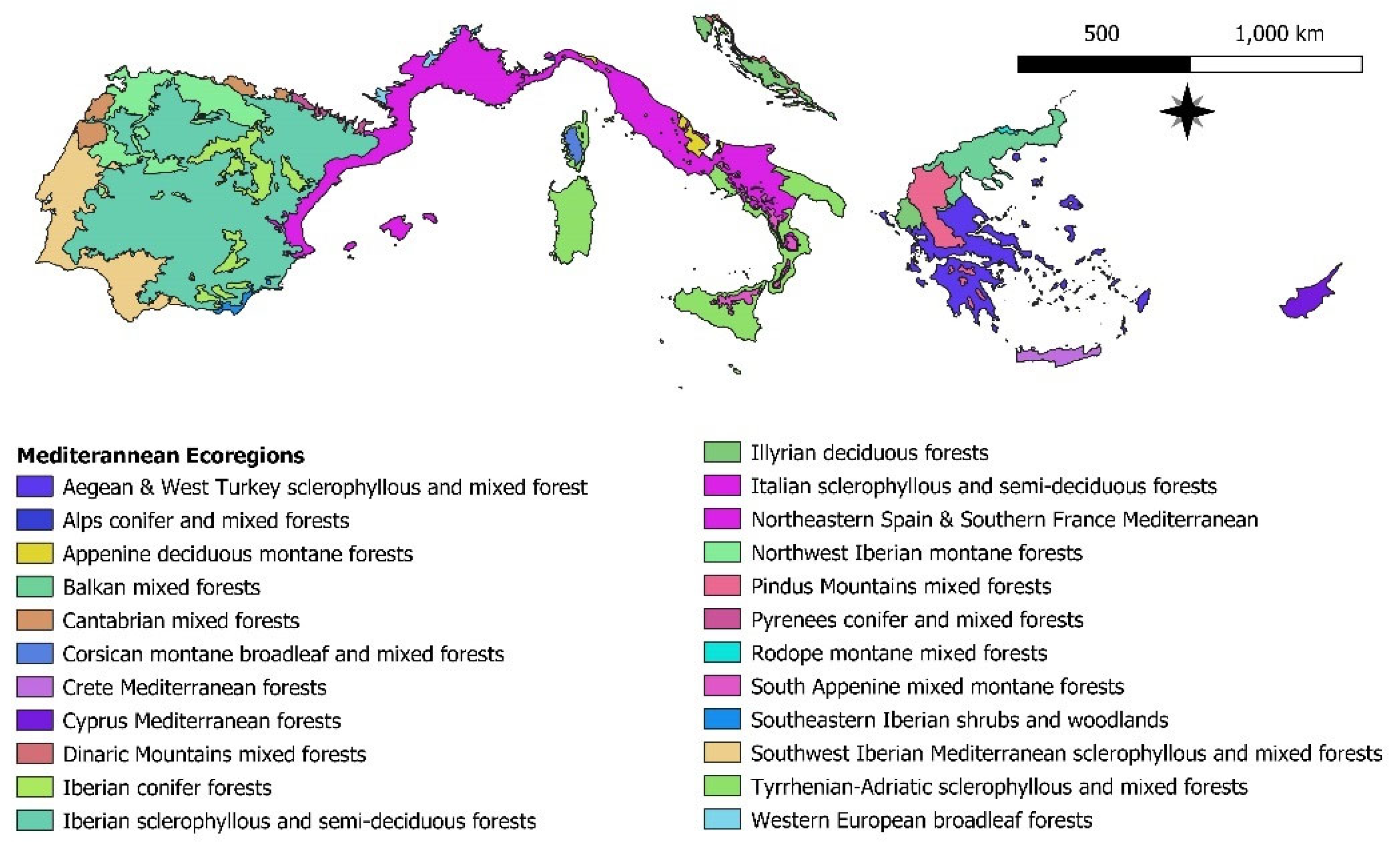


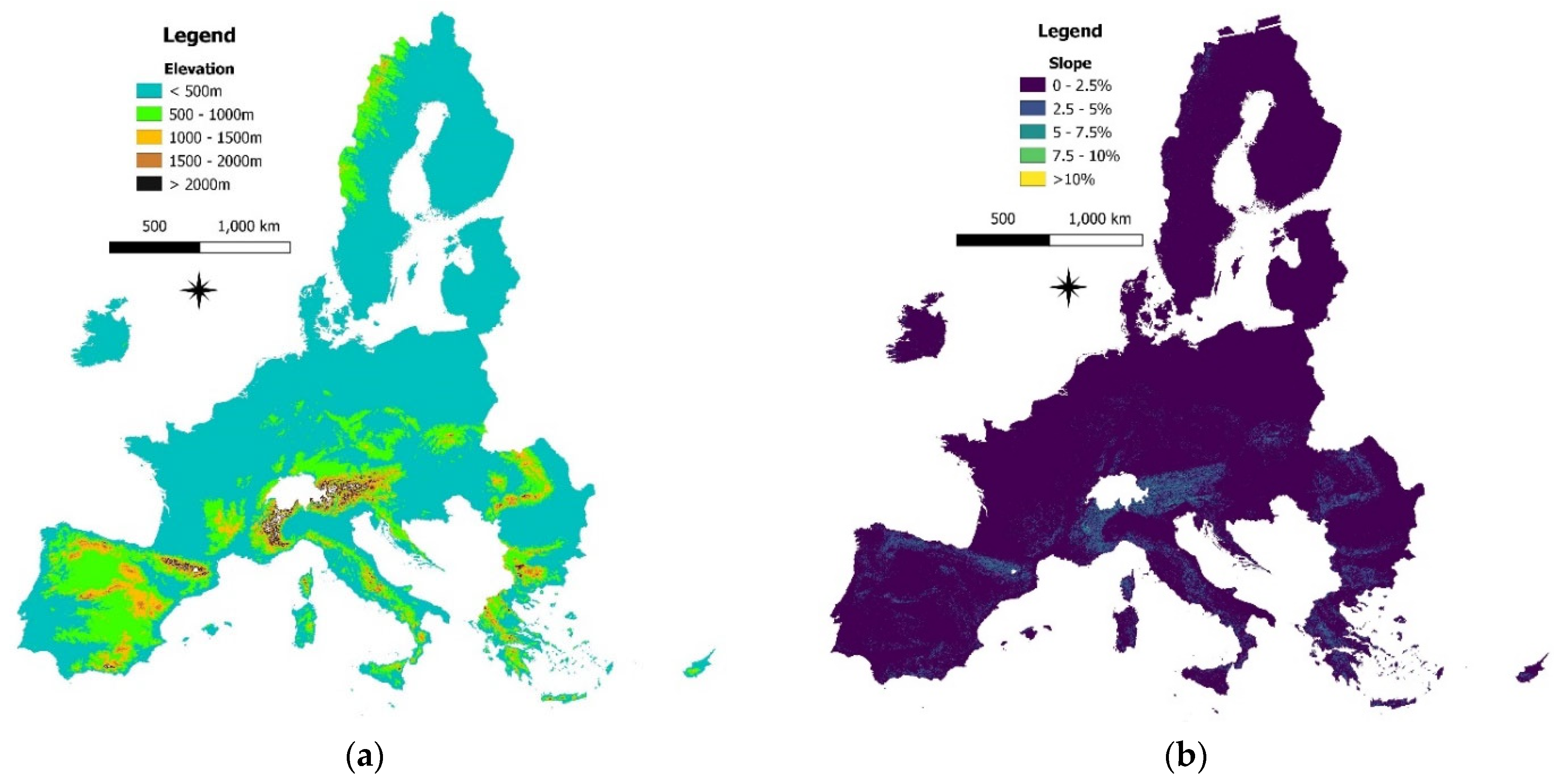

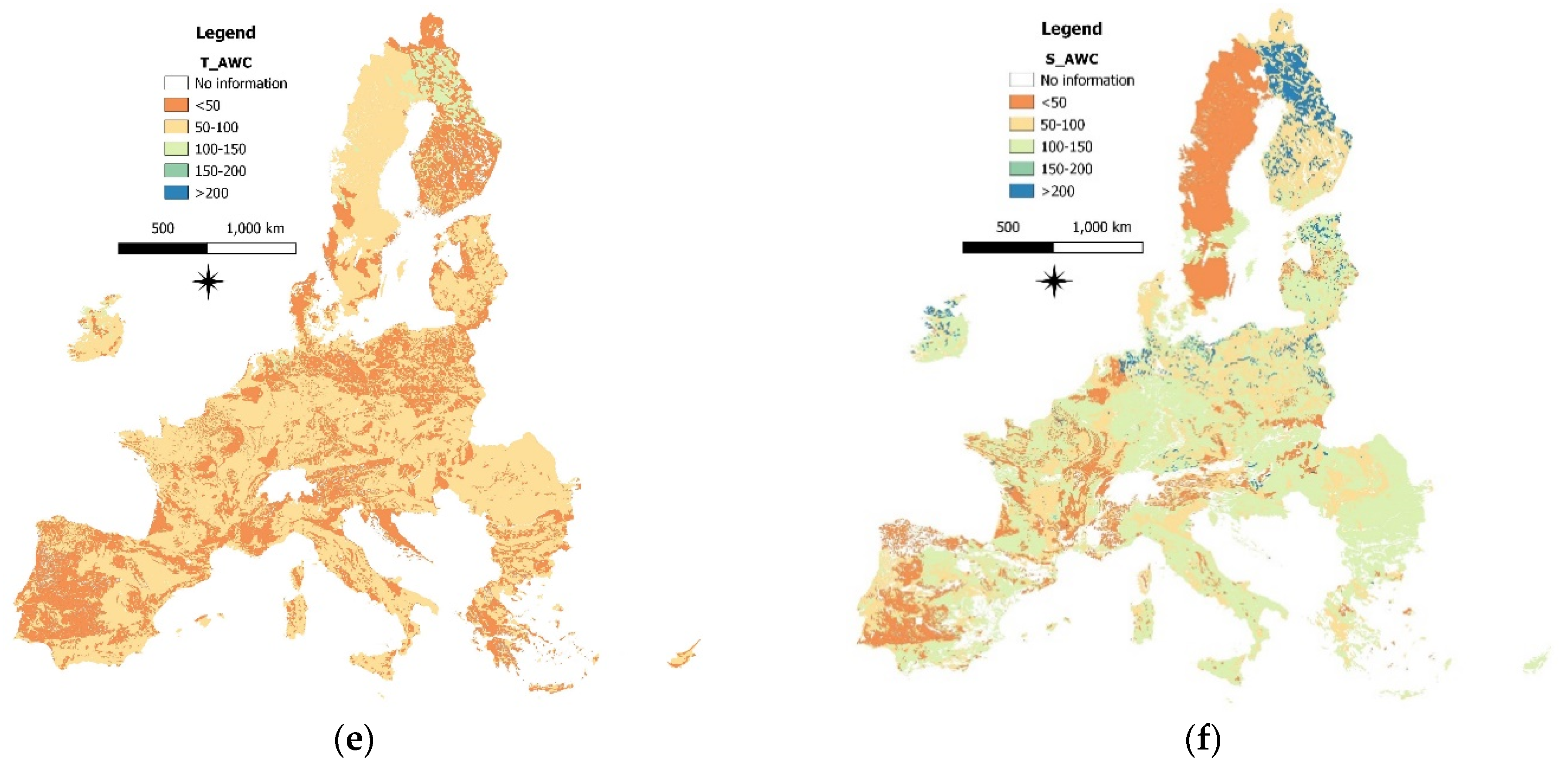
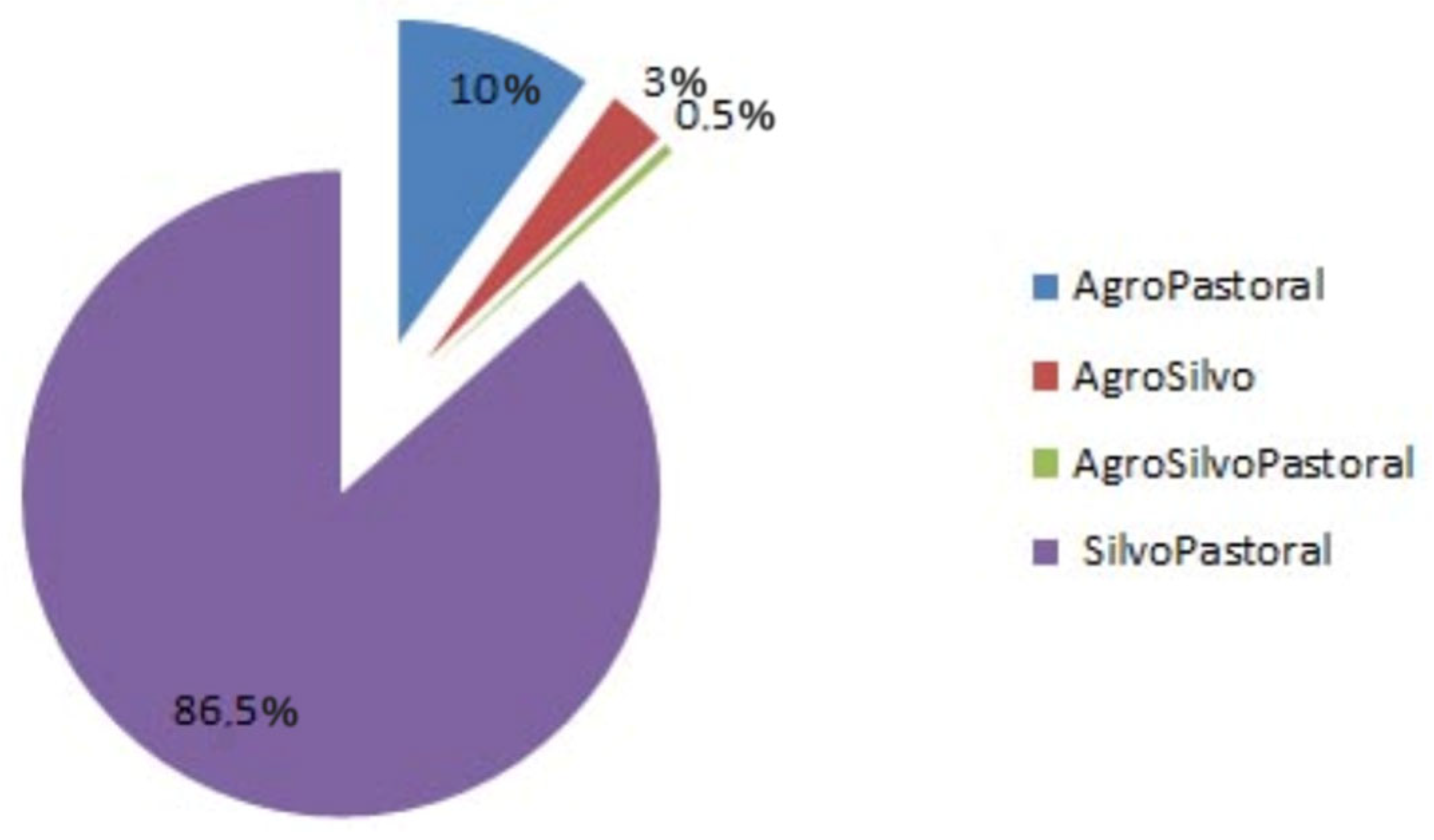
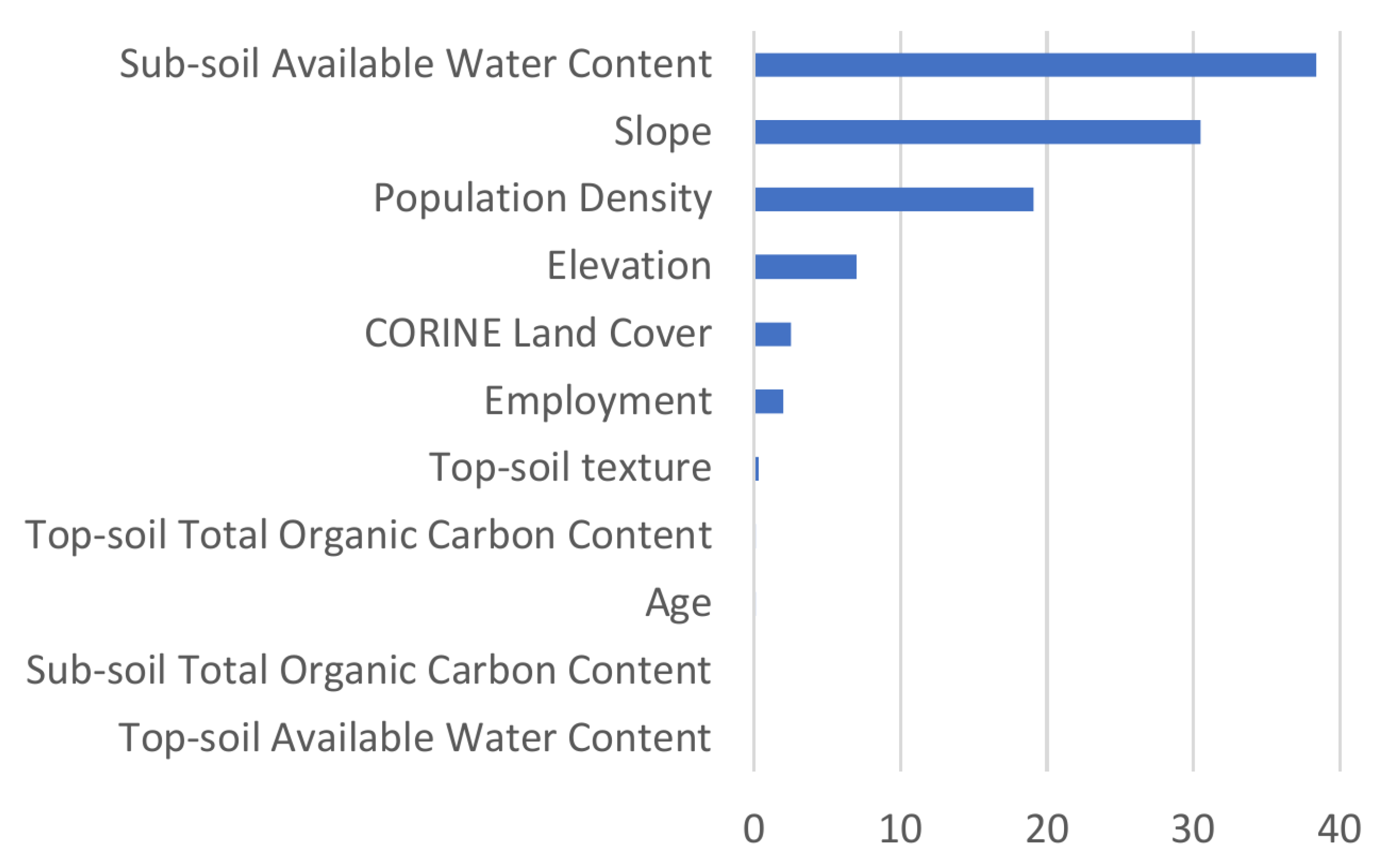
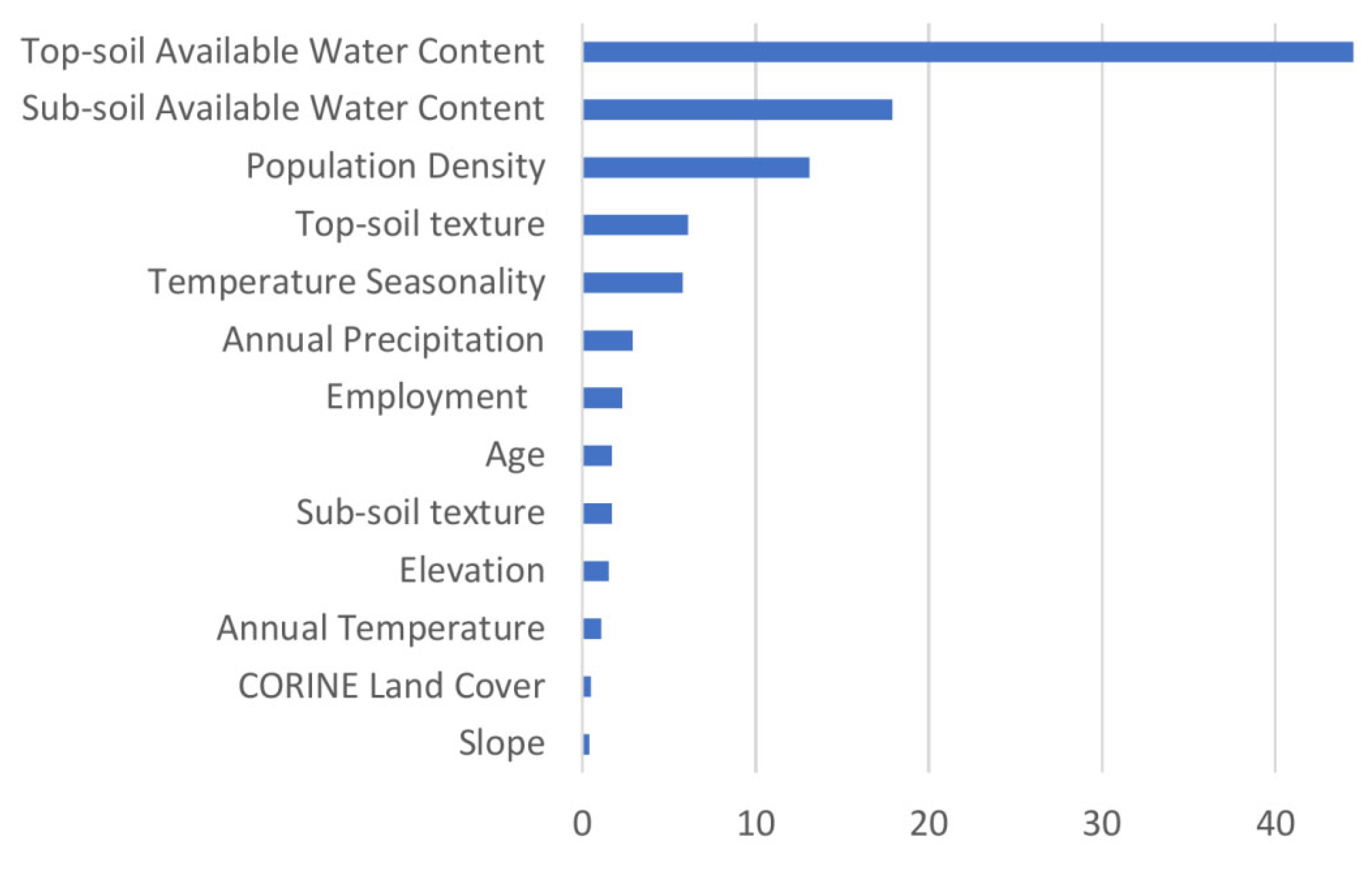
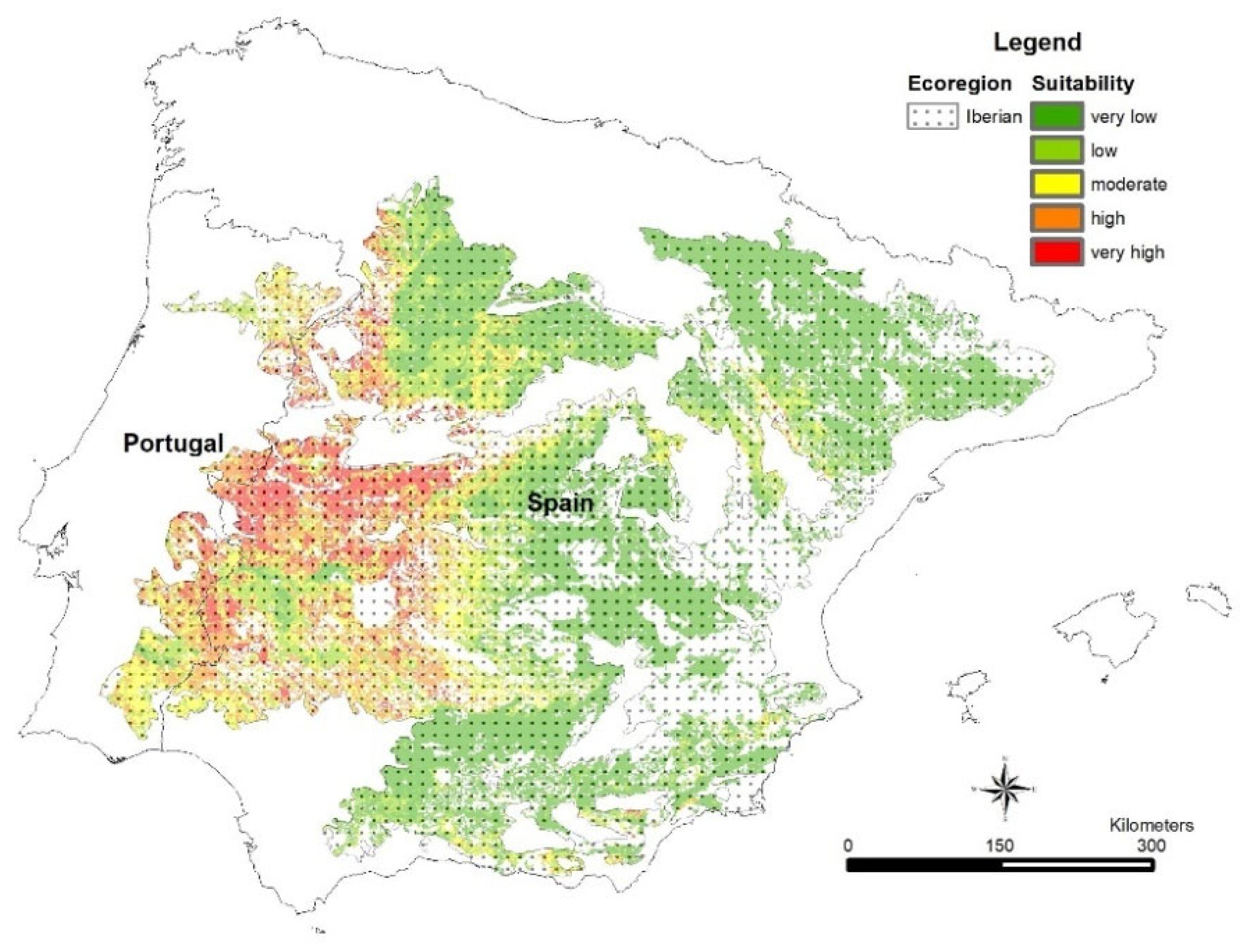
| Variable | Factor | Source | Resolution |
|---|---|---|---|
| Land cover type | Biophysical | Corine CLC 2018 | 100 m |
| Biogeographical region type | Ecological | European Environmental Agency | 500 m |
| Ecological region type | Ecological | European Environmental Agency | 500 m |
| Annual mean temperature (°C) | Bioclimatic | WorldClim | 1000 m |
| Temperature seasonality CV (standard deviation × 100) | Bioclimatic | WorldClim | 1000 m |
| Annual precipitation (mm) | Bioclimatic | WorldClim | 1000 m |
| Precipitation seasonality (Coefficient of Variation) | Bioclimatic | WorldClim | 1000 m |
| Elevation (m) | Topographic | Copernicus Land Monitoring Service (EU-DEM v1.1) | 25 m |
| Slope (°) | Topographic | Copernicus Land Monitoring Service (EU-DEM v1.1) | 25 m |
| Aspect | Topographic | Copernicus Land Monitoring Service (EU-DEM v1.1) | 25 m |
| Topsoil total organic carbon content (%) | Soil | European Soil Data Centre (ESDAC) | 1000 m |
| Subsoil total organic carbon content (%) | Soil | European Soil Data Centre (ESDAC) | 1000 m |
| Topsoil available water content (mm) | Soil | European Soil Data Centre (ESDAC) | 1000 m |
| Subsoil available water content (mm) | Soil | European Soil Data Centre (ESDAC) | 1000 m |
| Topsoil texture type | Soil | European Soil Data Centre (ESDAC) | 1000 m |
| Subsoil texture type | Soil | European Soil Data Centre (ESDAC) | 1000 m |
| Age of the population | Socioeconomic | EuroStat | NUTS3 |
| Employment (number of humans) | Socioeconomic | EuroStat | NUTS3 |
| Population density (humans/km2) | Socioeconomic | European Environmental Agency | 1000 m |
| Code | Description |
|---|---|
| 1 | Coarse (<18% clay and >65% sand) |
| 2 | Medium (18–35% clay and ≥15% sand, or <18% clay and 15–65% sand) |
| 3 | Medium fine (<35% clay and <15% sand) |
| 4 | Fine (35–60% clay) |
| 5 | Very fine (>60% clay) |
| 9 | No mineral texture (peat soils) |
| 0 | No information |
Disclaimer/Publisher’s Note: The statements, opinions and data contained in all publications are solely those of the individual author(s) and contributor(s) and not of MDPI and/or the editor(s). MDPI and/or the editor(s) disclaim responsibility for any injury to people or property resulting from any ideas, methods, instructions or products referred to in the content. |
© 2024 by the authors. Licensee MDPI, Basel, Switzerland. This article is an open access article distributed under the terms and conditions of the Creative Commons Attribution (CC BY) license (https://creativecommons.org/licenses/by/4.0/).
Share and Cite
Fotakis, D.; Karmiris, I.; Kiziridis, D.A.; Astaras, C.; Papachristou, T.G. Social-Ecological Spatial Analysis of Agroforestry in the European Union with a Focus on Mediterranean Countries. Agriculture 2024, 14, 1222. https://doi.org/10.3390/agriculture14081222
Fotakis D, Karmiris I, Kiziridis DA, Astaras C, Papachristou TG. Social-Ecological Spatial Analysis of Agroforestry in the European Union with a Focus on Mediterranean Countries. Agriculture. 2024; 14(8):1222. https://doi.org/10.3390/agriculture14081222
Chicago/Turabian StyleFotakis, Dimitrios, Ilias Karmiris, Diogenis A. Kiziridis, Christos Astaras, and Thomas G. Papachristou. 2024. "Social-Ecological Spatial Analysis of Agroforestry in the European Union with a Focus on Mediterranean Countries" Agriculture 14, no. 8: 1222. https://doi.org/10.3390/agriculture14081222





